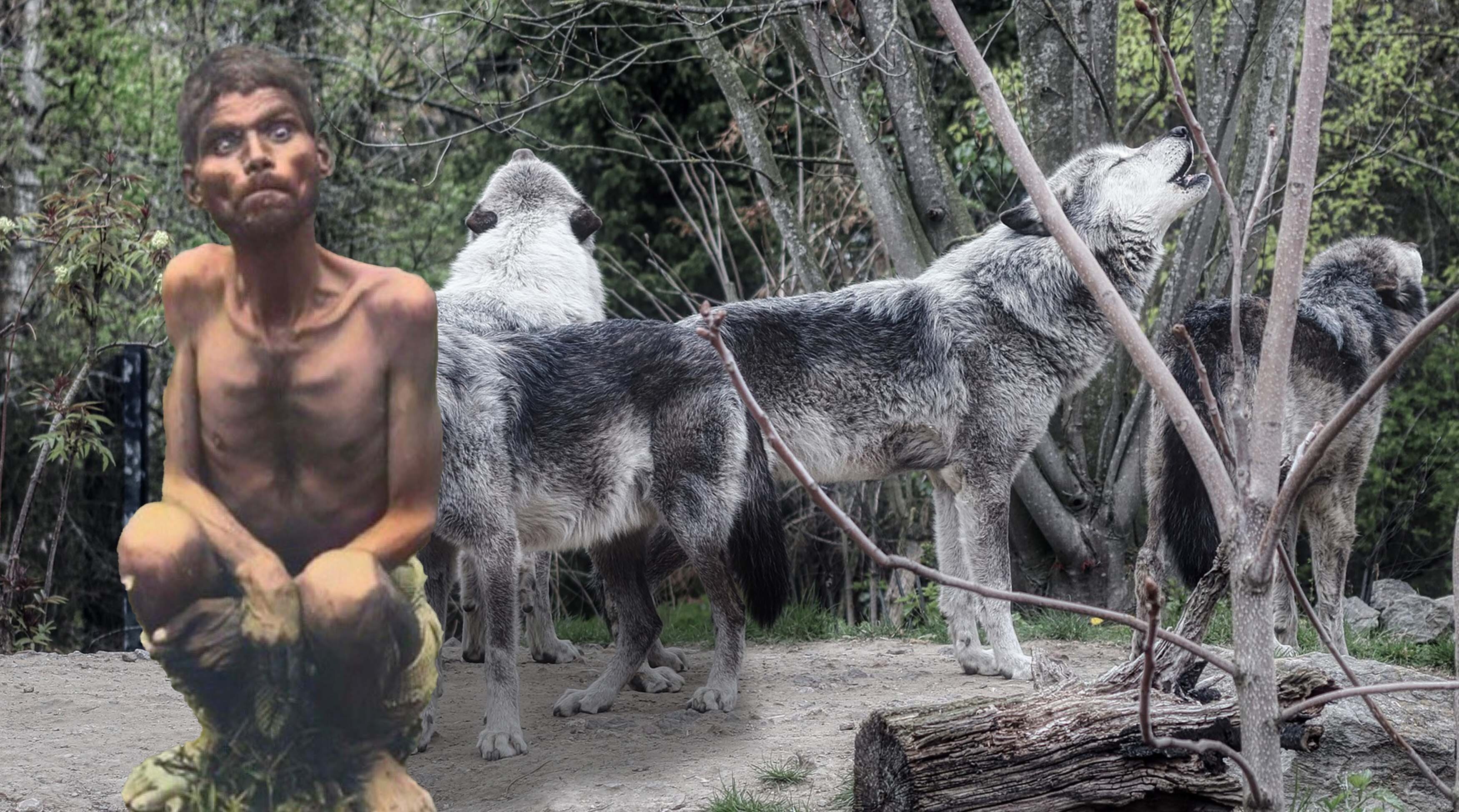Raised by Wolves: The Story of Feral Children
When you see a film like Tarzan or The Jungle Book, have you ever wondered if those were based on true stories? In this episode, you’ll find out! We talk about the case of Dina Sanichar and multiple other cases of “feral children” who were raised by animals in the wild. Then we bring on Mindreader, Eric Dittelman to play the quiz game!

The word “feral” is usually referring to animals. The official dictionary definition is “to exist in a wild state, especially after escape from captivity or domestication.” I think they add that last part because you wouldn’t say something like “A feral squirrel or a feral robin.” Or at least that’s not something you’d hear very often. But a “Feral cat” is common to hear because when you see a cat in the wild, it’s a pretty common assumption that maybe that used to be someone’s pet. There’s a feral colony of cats in my neighborhood and if you wanna know what it’s like to live in suburban ohio, there’s a Facebook group for my neighborhood and always lots of discussion about the cats. Enthralling stuff.
But what about feral humans? What would it take for a human to be feral? When Edgar Rice Burroughs was writing Tarzan, was that based on something that actually happened? Or was it all just imagination? Believe it or not, I found the answer to that!
Tarzan was first published in 1912, but in 1959 an article was written in Man’s Adventure Magazine called “The man who really was…Tarzan.” It was written by Thomas Llewellan Jones and described the story of William Mildin, the 14th Earl of Streatham, who was shipwrecked off the coast of West Africa in 1868 and lived for 15 years – from 11 to 26 – in the jungle. It was accepted as fact by many, and is still cited to this day as the real inspiration for Tarzan. The only problem? It’s 100% made up. No such man ever existed. So as far as we know, this idea of Tarzan the feral man was purely the work of Edgar Rice Burrough’s imagination.
But what about The Jungle Book? The Rudyard Kipling stories about Mowgli, Balloo and Shere Khan from 1894 could have possibly been patterned after some sort of real-life event, right? Well Kipling admitted to having taken the stories from Indian local urban legends. He said “Most of the native hunters in India today think pretty much along the lines of an animal’s brain and I have “cribbed” freely from their tales.” He said, “The idea of beast-tales seems to me new in that it is a most ancient and long forgotten idea. The really fascinating tales are those that the Bodhisat tells of his previous incarnations ending always with the beautiful moral.” So we have this story and lots of allegorical legends about the child that lives with beasts.
Take for instance, Remus and Romulus. This was an ancient myth about the founding of Rome. There are still statues of Romulus and Remus suckling on a she-wolf. The basic idea was that these were twin brothers that would inherit the throne, so they were cast out of society by King Amulius and left to die on the bank of the River Tiber. They found a she-wolf in a cave and the wolf kept them alive.
There are several other examples of mythical children being raised by beasts. Like Enkidu, who was raised by beasts in the Epic of Gilgamesh, or Pecos Bill in the American Southwest, who was said to be raised by coyotes. But these are just legends.
When he was writing The Jungle Book, Kipling may have actually had a real-life example of a boy raised by beasts. Many people through the years have said that Kipling used the example of Dina Sanichar – a real-life feral child.
In 1867 – this is 27 years before Jungle Book was published, a group of hunters were tracking wolves in India. The area was Bulandshahr in Uttar Pradesh, India. This is just east of New Delhi. So these hunters tracked a wolf into a cave and there they were amazed to find a six-year-old boy, living among the wolves. They took the boy to an orphanage in Agra and he was given the name Dina Sanichar. Sanichar means “Saturday” and he was given that name because that’s what day of the week he arrived. He would only eat raw meat and walked on all fours, leading his new caretakers to presume that he had only ever had the wolves to learn from. He couldn’t speak, but communicated with howls and growls. Sanichar was incredibly learning impaired and never learned to talk. He did take up smoking and supposedly smoked like a chimney. He lived among humans for the remainder of his life, which ended at a relatively young age when he died in 1895 from tuberculosis.
I found a mention written about Dina Sanichar from a book called “The Jungle Life in India.” This was written in 1880, so pretty contemporaneously to when it happened, and it was written by Valentine Ball, who worked in India for the Geological Survey of India. He says, “He is very much like a wild animal his very whine reminds one of a young dog or some such creature. Some year ago we had a similar child; he has picked up wonderfully, and though he has not learned to speak, can fully express his joys and grief. We trust the new ‘unfortunate’ may soon improve too.” In this case, sadly Ball was wrong. Sanichar never really improved. When he was admitted to the orphanage the records show one word under the column of state of health: “Idiot.”
There are plenty of photos of Dina Sanichar out there and when you see these photos, you can see how living in the wild affected him. He has the stare of a scared wild animal. He became famous as “The Wolf Boy of Northern India” and people came to the orphanage from far and wide to gawk at the poor boy.
There are multiple stories of feral boys that were brought into that orphanage throughout the years, and it turns out it was just sort of common for India at that time in history. There’s a story of a similar boy who was brought to the orphanage in Agra in 1872, and that story is often confused with that of Sanichar.
There are stories of humans being raised by wolves throughout history. But I was also really interested to find stories of people being raised by monkeys, dogs, goats and even bears!
When you get to these old stories, it’s really hard to prove how true they are. All you have to go on are whatever few written accounts existed. For instance, there are lots of stories about Hessian Wolf children from the 14th century, but those stories almost exist in the realm of legend because they’re really tough to prove. It seems like in all of them, the stories are about children who lived with a Eurasian wolf in the Forests of Hesse.
So let’s instead look at some more modern stories of this happening.
In 1954, a girl named Marina Chapman was kidnapped at the age of 5. Her captors drove her deep into the Colombian jungle and left her to fend for herself until they came back, which they never did. Apparently, she came across a family of weeper capuchin monkeys who largely ignored her, but weren’t bothered by her presence. When they moved, she moved with them and just stayed near as she stayed alive by eating whatever she could find around her. At one point, she ate tamarind which gave her horrible food poisoning and one of the older monkeys actually led her to water where she drank and nursed herself back to health. After that, the monkeys seemed to care for her and she lived in the trees with them, and continued living with the monkeys in the jungle until her rescue 4 years later. It seems almost too strange to be true.
In Uganda, John Ssebunya was orphaned as a toddler. He didn’t end up in an orphanage. Instead, he ran away into the jungle and lived with a group of vervet monkeys until the age of 7. The monkeys fed and protected John. After he was brought back into civilization, he only made monkey sounds and never learned to communicate with humans other than demanding food.
There are a few modern stories of kids being raised by dogs. Oxana Malaya was neglected by her parents in Ukraine. In 1991, she was only 3 years old and crawled out to the farmland near her home and lived with a pack of black russian terriers for the next 6 years. When she was picked up by Ukrainian human services at the age of 9, she walked on all fours and only communicated with barks and howls. She was eventually taught to speak, but her early years of neglect ended up giving her severe intellectual impairment. Similar stories have occurred in Russia, Romania, Siberia and Chile.
In Kyrgyzstan, a 14-year old boy was discovered living among a flock of sheep. He had reportedly been with the sheep for the last 8 years and they had protected him and led him to food.
In one of the stranger stories, there is a prominent 17th century story of a young boy living in the forests of Lithuania with a Eurasian Brown Bear. He’s known as the Lithuanian Bear Boy and apparently he was discovered in the spring of 1663, when he was removed from the forest and brought to Warsaw in Poland.
And what about birds? There was a North African boy, Sidi Mohamed, in 1945. At the age of six, he wandered away from his family and found an ostrich nest with chicks hatching, and somehow became friends with them. Like the wolves, dogs, monkeys and sheep, they took care of him, teaching him to run fast and sheltering him by each extending a wing over him. When he was discovered and returned to civilization at the age of 12, he was eating mostly grass.
All of these stories really have one sad fact in common. Neglect. So while it’s interesting and novel to think about these kids living with animals, it’s also very sad. So I think one of the ways we can think about this from a positive perspective is to think about these animals. There’s a subreddit on the internet called “Animals being bros” that just displays animals being friendly toward people. There’s something innate in many animals that allows them to be caring, nurturing and loving. And they can be very perceptive to know that a young child will die in the wild without their help. It’s an interesting study also in the nature vs. nurture debate. How much of our development is inborn versus what society teaches us? These cases tend to show exactly how important a loving caring home is to young people. And these cases also show that the real animals are the ones neglecting these kids in the first place.

Bonus episodes and content available at http://Patreon.com/MichaelKent
Review this podcast at https://podcasts.apple.com/us/podcast/the-internet-says-it-s-true/id1530853589
For special discounts and links to our sponsors, visit http://theinternetsaysitstrue.com/deals

